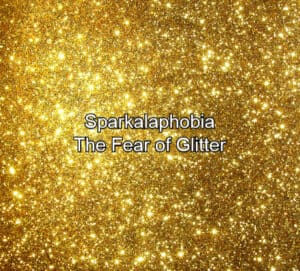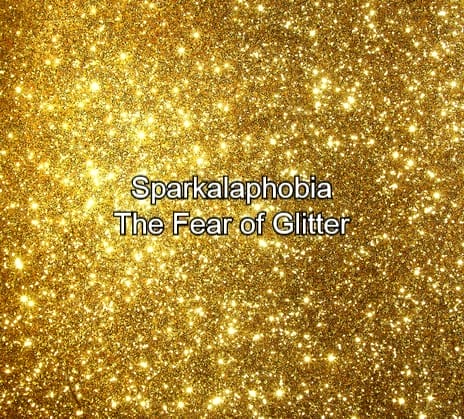Share This Article
Fear of Glitter: A Real Phobia? Yes.
Do you avoid decorations for fear of coming across something glittery or shimmery? Have you ever skipped out on attending a birthday party to avoid seeing anything glittery? Does the thought of accidentally getting glitter on your body cause you to sweat and go into a panic attack?
You’re probably facing a fear of glitter, also known as sparkalaphobia.
Like any other phobia, sparkalaphobia can be difficult to talk about. You may be afraid of sounding silly or of being mocked. But it’s important to know that this fear of glitter, though irrational, is a real fear that can be managed.
If you, too, are looking for ways to deal with this irrational fear, you’ve come to the right place. Keep reading as we decode the root cause of glitter phobia and help you find ways to overcome it.
What Can Cause the Fear of Glitter?
Sparkalaphobia causes can have multiple roots that can all influence whether a person develops this fear. Genetics and trauma are the two most common causes.
Genetics
If any of your family members were known to or have an anxiety disorder, you’re more likely to develop a phobia. But genetics alone don’t cause a phobia.
Traumatic Experiences
A traumatic experience surrounding the object of fear can also develop into a phobia.
In the case of sparkalaphobia, it may involve a situation where you were drenched in glitter and fell seriously ill shortly after. Or it may result from years of watching a close relative struggle with a phobia or severe anxiety.
Some Things You Need to Know about Sparkalaphobia
Sparkalaphobia is an irrational fear of glitter or shimmering, sparkly objects. A person with this fear may avoid coming in contact with glitter at all costs. That means avoiding parties and festive crowds, not looking at Christmas cards, or staying away from certain professions.
But how this fear manifests is not the same across the board.
Some glitter phobics will only fear loose glitter and not the closed glitter inside balloons or phone covers. Others, however, will be afraid of even the thought of glitter.
In extreme cases, a person who is scared of glitter may fear the presence of glitter even when they can’t see it. This isn’t uncommon considering how sneaky loose glitter can be when it’s out in the open.

Symptoms of Sparkalaphobia
Just like how a phobia’s intensity varies from one person to another, so can the symptoms of sparkalaphobia. Some people may only experience mild panic when around glitter or sparkly objects, whereas others will go into a full panic attack in a similar scenario.
In most cases, the symptoms will typically include some of the following:
Mental/Emotional Symptoms
- Intense fear or dread
- The need to escape
- Avoidance of glitter or situations that expose one to glitter
- Fear of losing control
- Sense of things being unreal
- Sense of impending death or doom
- Fear of dying
Physical Symptoms
- Chest pain
- Tingling sensation
- Sweating
- Trembling
- Nausea
- Dizziness
- Dry mouth
- Rapid heartbeat
- Shortness of breath
- Increased blood pressure
- Confusion
- Hot flashes or chills
Treatments for Sparkalaphobia
Sparkalaphobia may impact a person’s life on a day-to-day basis or only rear its head during the festive seasons. Either way, if your fear of glitter is preventing you from living life to the fullest, there are many ways you can take back control.
Self-Help
Self-help is a helpful strategy that can work for a diverse list of phobias. It involves helping yourself deal with the symptoms of the phobia, so you can lead a better life. Self-help methods also work hand-in-hand with professional treatment.
Lifestyle changes, for example, can help reduce the severity of your symptoms and also improve your overall physical and mental health. These changes can include healthier meals, proper sleep, regular exercise, and more.
Some may also find relief from their symptoms by cutting down on negative lifestyle habits, such as heavy caffeine consumption.
Meditation, deep or rhythmic breathing, and yoga are also great ways that can influence your anxiety responses and help you cope with your anxiety and panic.
Professional Help
Seeking professional help is a huge step for someone experiencing a phobia. It requires one to first accept the severity of their condition and acknowledge the need for intervention.
Here are some treatment pathways you’ll likely undergo during your professional treatment:
Cognitive Behavioral Therapy (CBT)
CBT is a top recommendation for anyone suffering from a phobia. It involves working on the glitter phobic’s thinking patterns and changing problematic thoughts into more constructive and positive ones.
Exposure Therapy (Desensitization)
Exposure therapy is the next best treatment for sparkalaphobia. In this type of therapy, the patient is gradually exposed to the object of their fear in a controlled environment to lessen their fear responses and desensitize them. A therapist will help you learn healthy ways of coping while you’re exposed to your fear.
Eye Movement Desensitization and Reprocessing (EMDR) Therapy
EMDR therapy is another popular form of treatment for PTSD and trauma responses. It uses eye movements or rhythmic tapping to influence the way your brain stores and analyzes painful memories.
EMDR works to desensitize you, so you can associate your traumatic memories with relaxation instead of stress or anxiety.
Learning to Cope with Sparkalaphobia
Overcoming your sparkalaphobia can be a long process. In the meantime, you want to learn strategies to help you cope with the object of your fear.
Talking to someone you trust is one of the best things you can do to help you in your journey of dealing with your fear. Confiding in a close friend or family member about your feelings can provide support and understanding.
You can also attend a self-help group where you can share your experiences with others facing similar issues. You may feel less lonely relating with others who are dealing with something similar. If you’re uncomfortable joining a public group, you can find similar support by writing your feelings down in a journal.
You may also want to consider learning more about your phobia by reading articles online or taking courses. Be cautious though; let someone else look up articles for you first so you don’t come across images that trigger your fear.
Let’s Conclude
Having a glitter fear can make an enjoyable life stressful and anxiety-ridden. And while overcoming fear is a challenge, it’s worth the reward of being able to have fun at a birthday party or New Year’s celebration.
And who knows, in time you may also feel comfortable walking into a party store or opening your holiday greetings cards yourself.



